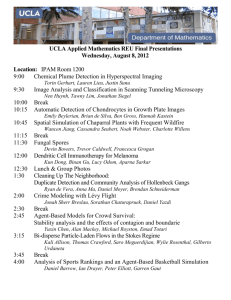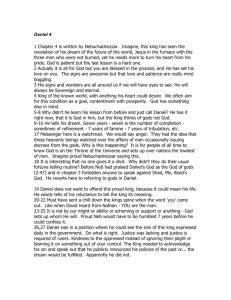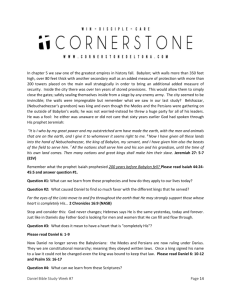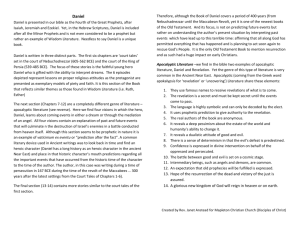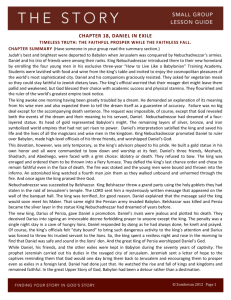OTS501_XI_Daniel and Hosea_2015
advertisement
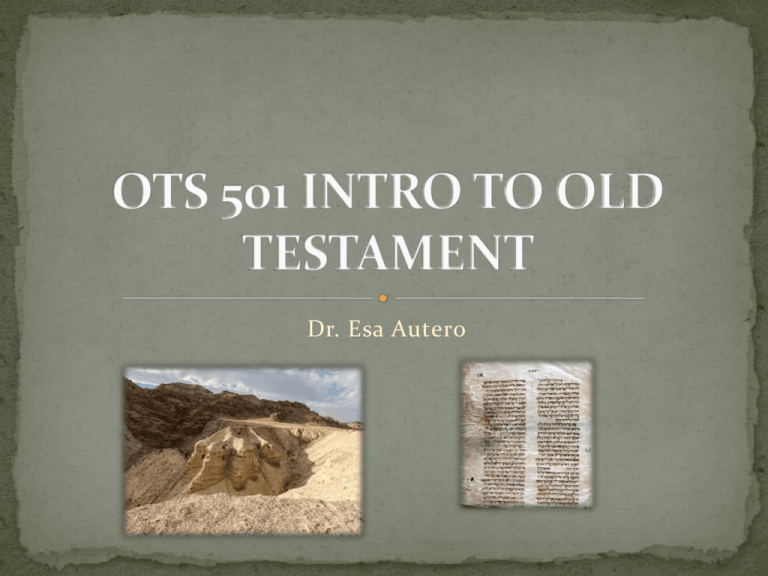
Dr. Esa Autero 1.1 Introduction to Daniel What are the most commonly known stories in Dan? In what setting are they often read/told? Most commonly focused issues in Daniel among evangelicals? Has your view of Daniel changed after reading the textbook and Daniel? If yes, how? 1.2 Historical and Critical Issues Authorship, composition, date Traditional view Unified work written by Daniel in the 6th century BC Questioned by critical scholarship b/c (cf. Porphyry AD 233-304) Challenge of historicity Challenge of unity Challenge of prophecy (and genre) Historical challenge Darius the Mede unknown in extra-biblical sources Satrapy system not until Darius Hystaspes (20 satraps over Persia) 7-year insanity of Nebuchanezzar unknown Chronological problem(s) 3rd yr. of Jehoiakim’s reign (609-598BC) & siege of Jerusalem by Nebuchanezzar (Dan 1:1) vs. 4th yr. of Jehoiakim = 1st yr. of Nebuchanezzar (Jer 25:1) Unity of Daniel challenge Chs. 1-6 have a positive view of gentile leaders whereas chs. 712 have a negative view Hebrew (1:1-2:4a & 8:1-12:13) and Aramaic sections (2:4b-7:28) Three additional stories in LXX 1) Prayer of Azariah and the Song of the Three Men 2) Susanna 3) Bel and the Dragon Challenge of prophecy (and genre) Stories in chs. 1-6 are court tales, legends, edifying stories Apocalyptic genre and ANE & Jewish parallels ANE Akkadian apocalypses Pseudonymity (e.g. 1-2 Enoch; 4 Ezra) and vaticinium ex eventu Accurate “prophecy” up to Antiochus IV (11:31-39; 168BC) but Antiochus’ death inaccurate (11:40-45 [†164/3BC]) Daniel written b/w 168-164BC [b/f Antiochus IV’s death in 163/4] How should one respond to these arguments? How important are the questions of historicity and accuracy? Some evangelical scholars spent lifetime researching Some challenges historical – others worldview & faith issues Some arguments from evangelical scholars Historical issues & attempts at solutions Darius the Mede (5:30; 9:1) – king after Belshazzar “Darius” as throne name – cf. e.g. Tiglath-Pileser = Pul (1Chr 5:26) Gubaru the governor (not general) of Babylon (from Akkadian texts) Cyrus the Great – “Darius”, adopted name to rule over Babylon (cf. 1Chr 5:26); kings could use two names for ruling over two different nations Cyrus ruled over a 14-month period through a vassal who was “king of Babylon” = Darius the Mede; Darius identified as Gubaru of Nabonidus Chronicles (‘general’ not ‘governor’ [see above]) All of these are possible suggestions not “hard evidence” Additional historical perspectives Belshazzar (5:1-2; 7:1; 8:1) “king of Babylon” Thought inaccurate 100 yrs. ago Nabodinus’ early “retirement” & son’s reign (Bel-šar-ușur) 7-year insanity of Nebuchanezzar No records of Nebuchadnezzar’s activities b/w 581-573BC except the siege of Tyre Chronological discrepancy (Dan 1:1 and Jer 25:1) Two systems of dating – ascension year and non-ascension year Chronology in Daniel and Jeremiah Ascension year Acc. yr. 1st yr. 2nd yr. 3rd. yr. Dan 1:1 Non-ascension 1st. yr. year 2nd yr. 3rd yr. 4th yr. Jer 25:1, 9; 46:2 Unity of Daniel and attempts at solution Changed circumstances & differences b/w 1-6 and 7-12 Also later editing could play a part Text indicates Daniel only as recipient of visions and object of stories Thematic unity of the book; connections b/w sections (2&7; 3&6) Additional stories in LXX Lack thematic unity of Daniel and likely legendary additions To add and heighten miraculous to the stories Prophecy and apocalyptic genre – solutions Chs. 1-6 appear as historical narrative Miracles, worldview, and “fantastic stories” – worldview issue Daniel and other apocalypses Not all apocalypses are pseudonymous (e.g. Revelation) Daniel – if pseudonymous, why not use a more prominent figure of the past (Noah, Abraham, Moses, Job etc.)? Definition of apocalypse – “prophetic-apocalyptic” continuum Vaticinium ex eventum, Antiochus’ death, and date of Daniel “abomination of desolation” Zeus’ altar in Temple in 167BC (11:31) Dan moves beyond Antiochus to Rome & distant future (7:23-5) Prophecy and “telescopic” view of the future Trans-historical nature of apocalyptic visions In support of earlier date Appears as a historical narrative (cf. Ezek 14:14, 20; 28:3) Not necessarily written by Daniel in whole Both Hb. and Aramaic style closer to 4th and 5th century than 2nd LXX (c. 250BC-150) and Qumran contain manuscripts of Daniel 4QFlor (cf. Matt 24:15; Ant. x.11.4 249) If Daniel written c. 164BC – how accepted into OT canon so quickly? Brief evaluation and remaining questions How close is Daniel to other apocalypses? Late date (c. 165BC), pseudonymity, and vaticinium ex eventum “prophecy” accepted by some evangelical scholars To what extent the message of Daniel is dependent on this? Some historical difficulties remain Date of Daniel 6th century BC to c. 165/4BC – mid 4th century possible too even if Daniel is considered the “fountain head” of the book 1.3 Background, purpose, structure Historical background Some important events and dates Nabopolassar enthroned king of Babylon 626BC Fall of Nineveh (Capital of Assyria) 612BC Fall of Carchemish 605BC Nebuchadnezzar enthroned king of Babylon 605BC First group of exiles to Babylon (Judah) 605BC Second group of exiles 598/7BC Fall of Jerusalem 587/6BC End of Nebuchadnezzar’s reign 562BC Fall of Babylon by Cyrus of Persia 539BC Assyria falls B A B Y L O N Persia Purpose of Daniel Demonstrate God’s sovereignty over the nations Situation of oppression Delay of establishing God’s kingdom (cf. 9:1-2) Kingdom not established after 70-year Exile Return from exile does not equal full restoration Endurance & faithfulness in the interim period Structure of Daniel Chs. 1-6 – from Nebuchadnezzar to the reign of Darius Daniel and friends in Babylon in king’s court (1-6) Nebuchadnezzar’s dreams and interpretations (2; 4) The world empires (cf. 7) and Nebuchadnezzar’s humiliation (4) Belshazzar’s feast and writing on the wall (5) Stories of deliverance (3; 6) – fire and lions Chs. 7-12 – 1st year of Belshazzar to 3rd yr of Cyrus Apocalyptic visions Four beasts and its interpretation – triumph of the kingdom (7) Ram and a Goat and its interpretation (8) Daniel’s prayer and the 70 weeks (9) Visions of heavenly powers, time of the End, resurrection (10-12) Delay of the kingdom & God’s ultimate triumph 1.4 Themes in Daniel God’s sovereignty and power of nations God’s control of gentile kings and nations (2:20-23; 4:17, 34-37) Sovereign control of history – visions of the kingdom (2; 7; 9) “Lord let…Jehoiakim…fall…” (1:2; 1:8) Nebuchadnezzar’s kingdom, insanity, worship (2:37-38, 46-47; 4:28-37) Raising and deposing of Belshazzar (5:13-31) Darius the Mede acknowledges God’s power (6:26-27) Visions of the nations’ rise and fall (2:24-45; 7:1-8:27; 7:11-12) God’s eternal reign and kingdom vs. temporal human reigns Comparison of the evil beasts and human-like God (7:1-28) Heavenly conflict & God’s triumph in human history (10:1-12:13) God’s protection and deliverance God’s protection of His people (1;3; 6) Supernatural protection of righteous (1:5-17;3:16-30; 6:16-28, 22) Revelation of the dreams to Daniel (2:10-12, 27-45; ) Daniel’s superior wisdom (1:18-20; 4:9; 5:12, 14; 6:3) Pride of the human rulers Nebuchadnezzar’s pride – golden statue (3:1-23; 5:18-21) Belshazzar’s pride (5:18-23) Darius’ pride – worship as a god (6:6-9) Ultimate triumph of the godly due to God’s kingdom God’s kingdom victorious (2:44-45; 7:9-18) Wickedness increases – “wise” suffer, fall, die (8:9-14; 11:33-35, 41; 2:17-18) Ultimate victory and the resurrection (12:1-4) Symbolism and prophetic visions The kingdoms and the kingdom – Dan 2 & 7 Nebuchadnezzar’s dream of the statue of four parts (Dan 2) Four successive kingdoms starting w/ Babylonia God’s kingdom smashes the fourth (2:44-45) Four beasts out of the sea (Dan 7) Four beasts & the coming of the Son of Man to the Ancient of D. Further query about the fourth beast – “different” from others Ten horns, , “another horn…three earlier plucked up” (7:7-9) Making sense of the strange visions(?) Most common suggestions Statue (Dan 2) & Beasts out of the sea (Dan 7) Head of gold/ 1st beast Babylonian empire Babylonian empire Babylonian empire Breast of silver/ Medo-Persian 2nd beast empire Median kingdom Medo-Persian empire Belly of brass 3rd beast Greek empire Persian empire Alexander the Great Legs of iron 4th beast Roman empire Greek empire Alexander’s successors message: God’s kingdom triumphs over earthly kingdoms Ram, He-goat, and horns (8:1-27) [8:1, 550/547BC] Ram w/ two horns = Medo-Persian empire [Persia = longer] He-goat from the west = Macedonian army [horn = Alex.Grt.] Four small horns = Alexander’s four generals “little horn” = Antiochus Epiphanes IV (215-163BC) – profaned the Temple 12/27 168BC (1Macc 1:54; 2Macc 6:2; Ant. xii.5.4.248-256) But what about “king of bold countenance” (8:23-26)? Vision “many days from now” (8:26) - “time of the end” (8:17) “End time” or “end of persecution” during Antiochus’ time? Was Antiochus IV “not destroyed by human hands”? Antiochus IV died of grief and remorse in Babylon (1 Macc 6:8-16) More generalized note of destruction by God Daniel’s seventy weeks (9:20-28) 70 weeks decreed for people and city - …put end to sin, atone for iniquity, everlasting righteousness…anoint holy… (9:24) 7 wks: from the time the word went out word to restore Jerusalem…[until an anointed prince – Hb. punct.] (9:24) For 62wks…Jerusalem…to be built…in troubled time (9:24) After 62wks anointed one cut off…troops destroy city and sanctuary…his/its end with a flood…war (9:26) 1wk & 1/2wk: strong covenant with many for 1 week – sacrifice ceases for ½ week, abomination of desolation…end to the desolator (9:27) How should these numbers and references be understood? Christ’s first and second coming/end times Time of the exile and the history up to Antiochus IV “Standard” prophetic evangelical understanding of “70 sevens” 70 weeks – 70x7 years = 490 yrs. 7 weeks (49yrs. b/w fall of Jerusalem and Cyrus’ decree) – “restore Jerusalem….until anointed prince” (9:25a) From exile to decree by Cyrus to rebuild the Temple in 538-537BC (Ezra 1:1-4; 6:3-5) or 458 Artaxerxes to Nehemiah (Ezra 7:11-26) or to Nehemiah 445-444 (Neh 2:5-8, 17-18) [ TIME GAP…] Hb. punctuation (cf. NRSV, NAB, NIV) “Time of an anointed prince” 1st coming of the Messiah (9:25b) 62 weeks [434yrs.] – anointed one cut off, city destroyed, war (9:26) Crucifixion of Messiah and destruction of Jerusalem AD 70 INDEFINITE TIME GAP… 1 week & 1/2 week – covenant, offerings cease, abomination, end Rise of antichrist characterized by week long covenant (7yrs); breaking of the covenant, abomination of desolation after ½ week (3.5yrs); destruction of the antichrist and the end More historically oriented understanding 70 weeks: 490yrs. OR symbolical for “period of history” From exile to restoration (Jubilee & Sabbath yr; cf. 1En; Jub) 7 weeks – “restore Jerusalem….until anointed prince” (9:25a) From exile (586BC) to decree by Cyrus (538BC) or Artaxerxes “Time of an anointed prince” Zerubbabel or Joshua (Ezra 2:2; 3:2; Hag 1:1-14; Zech 6:9-14) 62 weeks – anointed one cut off, city destroyed, war (9:26) 62wks = round number of the time down to Antiochus IV Anointed one = Onias III (†171BC; 2Macc32-34); prince = AntiochusIV 1 week & 1/2 week – covenant, offerings cease, abomination, end Antiochus’ covenant w/ apostate Jews (1Macc 1:11-15) Desecration of the Temple 167BC and his end 164BC Antiochus IV - a prototype for eschatological desecration & persecution Some interpretative principles Apocalyptic genre and imagery When to look for specifics and when broader principles/message Check for alternative interpretations – caution on dogmatism Primarily a sustaining word for first audience or future prophecy? Telescopic vision – near at hand and distant future merged e.g. “kingdom not made w/ hands” did not replace Antiochus IV’s rule as a historical reality Vision sealed and secret until the end of times (12:9) 2.1 Introduction to Hosea What kind of person was Hosea? What did God ask Hosea to do? Sermons from Hosea? 2.2 Historical and Critical Issues Author, composition, date Hosea the son of Beeri (1:1) – author or main figure? The dates of the kings and Hosea’s ministry Kings of Judah and Israel (Hos 1:1) Judah’s kings Uzziah 785733[42] Jotham 758743[32] Ahaz 743-727 Hezekiah 727698[87] Israel’s kings Hosea Jeroboam II 789-746[53] P R Zachariah, 6 months, 1 O P Shallum month H Menahem 747-37[42] E C Pekahiah & 737-735 Y Pekah 735-732 750-746 Hoshea 732-724 Hosea prophesied against the northern kingdom Why most kings in 1:1 are from Judah? Number of references to Judah (1:7; 2:2; 4:15; 5:5-14; 6:4-11; 8:14…) Hosea prophesied to both? Prophetic vision for both Prophecies to both by Amos (2:4-8) and Isaiah (5:7; 48:1) Judah and Israel are envisioned together Later editing or “Judean redaction”? (cf. 12:2) Prophecies from Israel later applied to Judah b/c similar situation Book of Hosea – dated to c. 722BC Or later (exilic) if it had a Judean “updating” 2.3 Background, purpose, structure Historical background Hosea, son of Beeri “deliverance”, “help”, “salvation” (cf. Joshua, Isaiah, Jesus) 8th century pre-exilic prophet Contemporary of Isaiah, Micah, and Amos Married Gomer “take…wife of whoredom” (1:2; 3:1) Symbolize the apostasy of Israel & YHWH’s love toward Israel Children’s names & judgment – Jezreel*, Lo-Ruhamah, Lo-Ammi Historical situation Jeroboam II’s military expansion (2Kgs14:25-28) Economic prosperity Idolatry, moral decay, and apostasy (4:2, 18; 6:8-9; 10:15; 11:2) Political instability and assassinations Syro-Ephraimite conflict & war (735-734BC; cf. 5:8-6:6) Attempts at foolish diplomacy (7:11) Menahem a vassal of Assyria to avoid invasion 740BC (2Kgs 15:19) Pekah’s raid into Judah in 735BC (2Kgs 16:5-9) Ahaz of Judea sought help from Assyria King Hoshea sough help from Egypt (2Kgs17:1-6) Purpose of Hosea “Immediate doom, eventual hope” Call to repentance of the apostate nation Dramatization of YHWH’s faithfulness to Israel (14:4) YHWH’s dilemma of punishing beloved children (11:8) Recounting of past deliverance and covenant (11:1-4; 12:2-6, 9) Structure – basic division 1-3 & 4-14 Hosea’s marriage w/ Gomer (1:2-3:5) Reflection of God’s relationship w/ Israel First prophetic cycle (4:1-11:11) Oracles of judgment (4:1-10:15) God’s love overwhelms His anger (11:1-11) Second prophetic cycle (11:12-14:8) Israel’s sins and God’s anger (11:12-13:16) Israel’s repentance and blessing (14:1-8) Wisdom colophon (14:9) 2.4 Themes in Hosea The covenant – judgment and salvation Mosaic covenant – blessings and curses presupposed “hunger and fertility” curse (Deut 28:17-18) & Hos 4:10-11 Judgment b/c breaking the covenant (6:7; 8:1) “lack of knowledge” (4:1, 6) – “spirit of whoredom” (5:4) Idolatry (4:1-13; 5:11; 8:6; 13:2) & “return to wilderness” (2:14) Lying, deceit, sexual sins (4:2, 14, 18; 6:7-11) Socio-economic injustice and oppression (12:6-8; 9:9; 7:1; 6:6; 5:10) Second exodus and restoration (2:14-15; 11:8-9) Salvation as healing/restoration of the nation and the land (6:1-3; 11:3; 14:4) Reflecting on salvation, judgment & the creation care God’s judgment and desolation of the earth (4:2-3) Salvation and the healing of the earth (2:18-19, 21-22) Creation imagery related to salvation/judgment (2:6, 12; 8:7; 10:8; 14:4-7) Baal and the fertility cult Manipulation of divine forces to bring about harvest Identification of natural forces (rain, thunder etc.) w/ divinity YHWH – Creator and Savior/provider The connection b/w covenant faithfulness & the creation Does this have any implications how we treat the creation? http://www.creationcare.org/index.php evang. environt. network Hosea’s marriage Analogy b/w human marriage and divine-human covenant Israel’s infidelity to the covenant and Gomer’s infidelity Exclusive nature of marriage and covenant Was Hosea’s marriage literal or symbolical? (1:2 & 3:1) Hypothetical, allegorical or prophetic vision One literal marriage: was Gomer a prostitute all along/became one? Two literal marriages: marriage to Gomer (1:2) and another marriage of an unknown woman (3:2) An option – one marriage to prostituting Gomer 1:2 and 3:1 two separate events After the initial marriage Hosea had to purchase her from slave market to redeem her from debt and prostitution How could God ask such an unethical thing? Only priests were forbidden marry a prostitute (Lev 21:7, 14) To enact YHWH’s covenant love and Israel’s unfaithfulness
